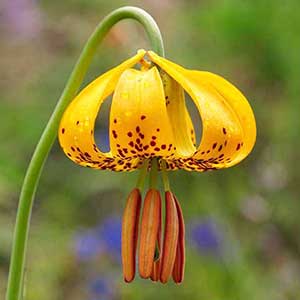Lilium columbianum
Lilium maritimum
Columbia lily, Columbia tiger lily, Columbian lily, Oregon lily, tiger lily
coast lily
variable, subrhizomatous to ± ovoid, 3.1–8.1 × 3.6–10.6 cm, 0.3–1.4 times taller than long;
scales 2–3(–5)-segmented, some unsegmented, longest 3.1–7.3 cm;
stem roots absent.
rhizomatous, often irregular, unbranched, continuously scaly, 1.8–4.1 × 3–7.4 cm, 0.3–0.9 times taller than long;
scales usually unsegmented, a few 2-segmented, longest 1.5–3.8 cm;
stem roots absent.
to 1.7 m, glaucous or not.
to 1.2(–2.3) m, plants on coastal bluffs shorter than 0.25 m. Buds rounded in cross section.
rounded in cross section.
in 1–9 whorls or partial whorls, 3–25 leaves per whorl, usually ascending, 1.7–15.7 × 0.4–4.7 cm, 2.4–7.4 times longer than wide;
blade weakly oblanceolate to obovate or ± elliptic, margins usually somewhat undulate, apex acute;
veins and margins ± smooth abaxially.
sometimes concentrated proximally, scattered or usually in 1–3 whorls or partial whorls, 3–17 leaves per whorl, horizontal and drooping at tips to ascending, 3.6–17.7 × 0.3–4.7 cm, 2.4–18 times longer than wide;
blade elliptic, sometimes narrowly so, rarely weakly oblanceolate or obovate, margins not undulate, apex acute or narrowly so;
veins and margins ± smooth abaxially.
racemose, 1–25(–45)-flowered.
racemose, 1–13-flowered.
pendent to nodding, not fragrant;
perianth Turk’s-cap-shaped;
sepals and petals reflexed 2/5–1/2 along length from base, yellow or orange to occasionally red, with copious maroon spots, often darker and especially reddish abaxially, not distinctly clawed;
sepals not ridged abaxially, appearing wide for their length, 3.4–7.1 × 0.8–1.9 cm;
petals 3.5–6.9 × 0.8–1.9 cm;
stamens barely to moderately exserted;
filaments moderately spreading, diverging 10°–20° from axis;
anthers pale yellow to yellow, 0.5–1.3 cm;
pollen orange or yellow;
pistil 2.4–3.7 cm;
ovary 1.1–2.2 cm;
style green;
pedicel 2.8–20.2 cm.
nodding, rarely horizontal, not fragrant;
perianth campanulate;
sepals and petals reflexed or rolled 1/2–4/5 along length from base, red or red-orange, with maroon spots concentrated proximally along longitudinal median and surrounded by light orange or occasionally yellow-green, not distinctly clawed;
sepals not ridged abaxially, 3.4–5 × 0.9–1.3 cm;
petals 3.5–5 × 0.9–1.3 cm;
stamens included;
filaments somewhat spreading, diverging 3°–14° from axis;
anthers light magenta, 0.4–1.2 cm;
pollen orange;
pistil 2.2–3.2 cm;
ovary 1–1.8 cm;
style green;
pedicel 6.3–32 cm.
2.2–5.4 × 1.1–2 cm, 1.7–3.3 times longer than wide.
2.4–4.1 × 1.2–2 cm, 1.5–2.4 times longer than wide.
135–330.
120–237.
= 24.
= 24.
Lilium columbianum
Lilium maritimum
The author citations often seen for this species derive from Baker (1874), who published the name as Lilium columbianum “Hanson in hort., Leichtlin”; this authority is given by various later writers as Hanson, or Baker, or Hanson ex Baker. However, Ducharte’s (1871) recapitulation of a letter from M. Leichtlin is apparently the first confirmed and valid publication of L. columbianum, and hence that citation is used here.
This widespread lily is rather variable. In California plants the stamens are considerably less exserted than those of plants found farther north. Lilium columbianum may intergrade with L. kelloggii along Highway 199 at the border between California and Oregon; these plants are slightly fragrant, the stamens moderately exserted, and the bulb scales unsegmented. Lilium columbianum hybridizes with L. pardalinum subspp. wigginsii and vollmeri, and extensively with L. occidentale in Oregon.
Lilium columbianum is pollinated primarily by rufous hummingbirds [Selasphorus rufus (J. F. Gmelin), family Trochilidae] and to a lesser extent by large butterflies, including the pale swallowtail (Papilio eurymedon Lucas, family Papilionidae).
Native Americans used Lilium columbianum bulbs as a food or peppery condiment, sometimes mixed with meat or salmon roe. For many, it was a staple food (J. Pojar and A. MacKinnon 1994).
(Discussion copyrighted by Flora of North America; reprinted with permission.)
Of conservation concern.
Lilium maritimum is known in California from below San Francisco to about Westport in Mendocino County, and invariably grows within a few miles of the ocean. The coast lily has suffered grave declines in the past century and has been extirpated from the southern part of its range. The recent rediscovery of a population in Marin County at Point Reyes National Seashore is heartening, but development of coastal prairie farther north continues to be a threat.
The combination of nodding habit and campanulate perianth with rolled sepal and petal tips is unique among the North American lilies. Hybrids with Lilium pardalinum are known; these can be clonal and their flowers are morphologically intermediate between the parents.
Lilium maritimum is pollinated sequentially, first by Allen’s [Selasphorus sassin (Lesson), family Trochilidae] and Anna’s hummingbirds [Calypte anna (Lesson)], and later in the blooming cycle by several different bumblebees (Bombus Latrielle, family Apidae).
(Discussion copyrighted by Flora of North America; reprinted with permission.)
- Local floras:
BC,
CA,
OR,
WA
- Local Web sites:
CalFlora,
CalPhotos,
Flora NW,
PNW Herbaria,
Turner Photog.
WildflowerSearch
iNaturalist (observations)
USDA Plants Database
- LBJ Wildflower Center
- SEINet
- Plants of the World Online
- Encyclopedia of Life
- Wikipedia
- Google Image Search


